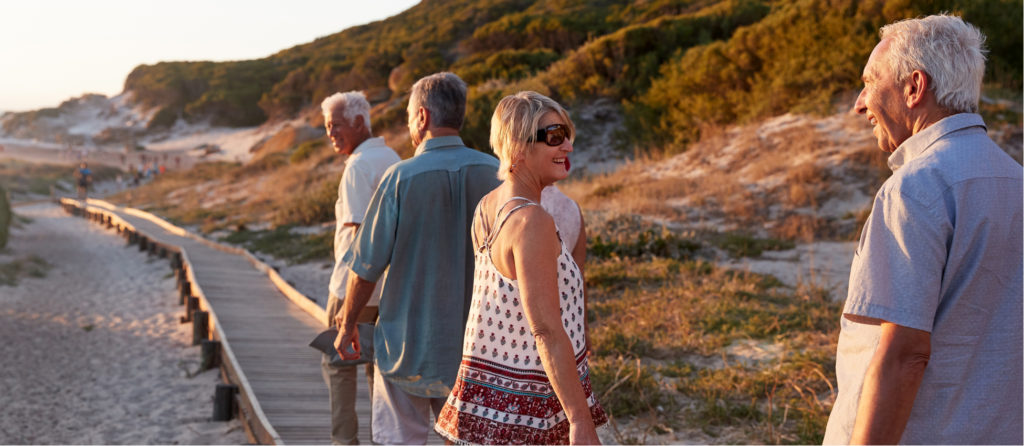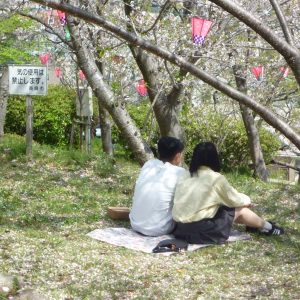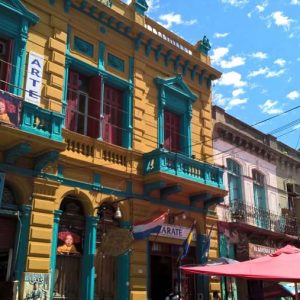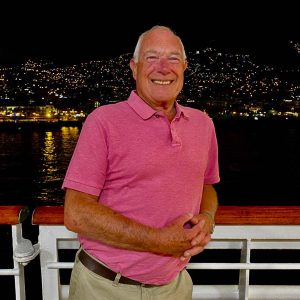An exciting Pandaw river cruise through South East Asia’s least-known destination
As the heat filled the oiled rice paper we waited for the optimum moment until our guide Vieng told us to let go and make a wish. One after the other the bamboo-framed lanterns rose up into the inky night sky from the sand bar, creating a mirror image on the Mekong below.
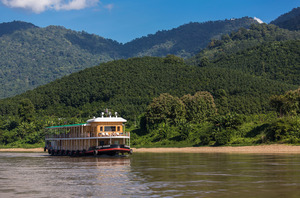 It was a truly magical moment and the traditional khom loy, or sky lantern, ceremony was a world away from the plethora of parties and events in the UK that have hijacked these oriental lights to provide a novelty factor, whereas in Laos the lanterns represent Buddha’s power to dispel darkness.
It was a truly magical moment and the traditional khom loy, or sky lantern, ceremony was a world away from the plethora of parties and events in the UK that have hijacked these oriental lights to provide a novelty factor, whereas in Laos the lanterns represent Buddha’s power to dispel darkness.
We were less than halfway through our cruise along the Upper Mekong and it was another totally authentic experience in a trip where we’d already had impromptu invitations to celebrate life’s dichotomy, from the birth of a baby to a funeral. In between, each day brought temple visits, spiritual rituals, rural walks and other memories all combined with a real river adventure.
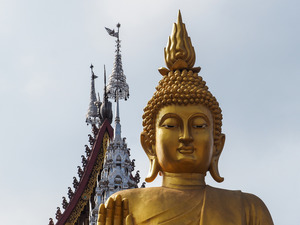 The smallest country in South East Asia, landlocked Laos is surrounded by the household names of Thailand, Vietnam, Cambodia, Burma and the vastness of China. Many people – including the bank representative I called to make sure there’d be no problems with my credit card – are hard pressed to even know where it is. This makes it irresistibly remote and unknown for anyone with a wanderlust, and Pandaw is the only river cruise company operating along the Mekong from Thailand to the Laotian capital of Vientiane were fast-flowing stretches of the water are interspersed with rapids.
The smallest country in South East Asia, landlocked Laos is surrounded by the household names of Thailand, Vietnam, Cambodia, Burma and the vastness of China. Many people – including the bank representative I called to make sure there’d be no problems with my credit card – are hard pressed to even know where it is. This makes it irresistibly remote and unknown for anyone with a wanderlust, and Pandaw is the only river cruise company operating along the Mekong from Thailand to the Laotian capital of Vientiane were fast-flowing stretches of the water are interspersed with rapids.
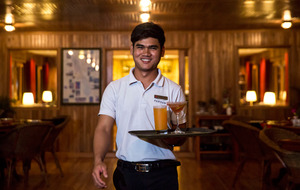 Our journey began in Thailand’s northern province of Chiang Rai, home to the once notorious drug trading zone of the Golden Triangle where Thailand, Laos and Burma meet. Today this dark past is showcased in the modern Hall of Opium Museum, which provides a captivating yet sobering insight into the origin of opium, subsequent wars and the ongoing battle against opium and poppy growing.
Our journey began in Thailand’s northern province of Chiang Rai, home to the once notorious drug trading zone of the Golden Triangle where Thailand, Laos and Burma meet. Today this dark past is showcased in the modern Hall of Opium Museum, which provides a captivating yet sobering insight into the origin of opium, subsequent wars and the ongoing battle against opium and poppy growing.
In the afternoon we boarded our ship, the 28-passenger Champa Pandaw, a pleasingly old-style colonial vessel where the gleaming teak decks and brass fittings belie the fact it was only built in 2016. It is part of the fleet of small river ships created by historian and trailblazer Paul Strachan to replicate the ships of the 19th century Scottish-owned Irrawaddy Flotilla Company that once dominated the waterways of his beloved Burma. Originally built in his Scottish homeland, and transported and reassembled overseas, the fleet was scuppered in the Second World War to prevent the invading Japanese from commandeering the vessels.
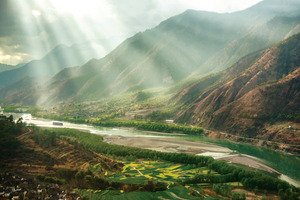 This pioneering spirit set the scene for our cruise where mornings began with ethereal misty sunrises set against the backdrop of tapering mountains and lush jade jungles. Even though the scenery changed little on some days, there was always something to see; the tips of golden temples and Buddha statues peeking above the trees, water buffalo cooling off in the shallows, temporary waterside gardens built on the fertile soil left by the receding river in the dry season, fishermen crossing our path in shallow wooden boats and the silence only occasionally broken by passing motorboat.
This pioneering spirit set the scene for our cruise where mornings began with ethereal misty sunrises set against the backdrop of tapering mountains and lush jade jungles. Even though the scenery changed little on some days, there was always something to see; the tips of golden temples and Buddha statues peeking above the trees, water buffalo cooling off in the shallows, temporary waterside gardens built on the fertile soil left by the receding river in the dry season, fishermen crossing our path in shallow wooden boats and the silence only occasionally broken by passing motorboat.
Most days there were walks around riverside villages, where we clambered up mud steps hewn into the bank assisted by vigilant crew members. 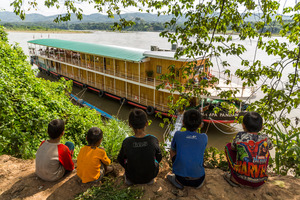 Our ungainly progress was observed by doe-eyed children who gathered to watch the unexpected live entertainment. With the itinerary dictated by Mother Nature and the Mekong, our fast downstream journey was punctuated by extra village stops which in a few instances the ship had only visited on one or two occasions, sometimes never before. Our guide explains about the differences between the lowland and upland tribes that make up the country’s distinctive ethnic groups, 49 in total.
Our ungainly progress was observed by doe-eyed children who gathered to watch the unexpected live entertainment. With the itinerary dictated by Mother Nature and the Mekong, our fast downstream journey was punctuated by extra village stops which in a few instances the ship had only visited on one or two occasions, sometimes never before. Our guide explains about the differences between the lowland and upland tribes that make up the country’s distinctive ethnic groups, 49 in total.
In one community an 80-year-old man who has outlived his six wives came out to play us tunes on a bamboo woodwind instrument called a khene, while in the background a young woman carried an incredible 37kg sack of tree resin on her back ready to take to the market. Elsewhere we visited schools, where the initially shy children showed us their books and giggled delightedly when we in turn let them see our photos.
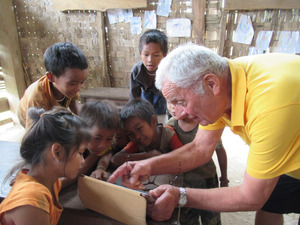 These cameos of day-to-day life are intermingled with excursions to spectacular sights such as the Pak Ou Buddha caves, set in sheer limestone cliffs and housing thousands of Buddha statues. The spectacle of the Kuang Si waterfalls, cascading 250ft into a series of hillside pools, is also the location of the heart-warming Free the Bears sanctuary providing a new life for bears rescued by the charity from the living hell of Asian bile farms.
These cameos of day-to-day life are intermingled with excursions to spectacular sights such as the Pak Ou Buddha caves, set in sheer limestone cliffs and housing thousands of Buddha statues. The spectacle of the Kuang Si waterfalls, cascading 250ft into a series of hillside pools, is also the location of the heart-warming Free the Bears sanctuary providing a new life for bears rescued by the charity from the living hell of Asian bile farms.
The cruise is book-ended by the cities of Luang Prabang, a UNESCO World Heritage Site, and the compact capital of Vientiane where we took a spluttering tuk-tuk ride to the night market from our mooring spot on the outskirts. Luang Prabang, the former capital, is the prettier with its colonial architecture, coffee shops and bakeries that are little changed since Laos became a French protectorate in 1893, achieving independence in 1954. A guided tour around the former royal palace revealed rather austere private quarters that were in stark contrast to opulent public rooms decorated with glittering glass murals of Laotian life. Lining the visitor route are pictures depicting one of the country’s many mythological tales, often convoluted and featuring fabulous beasts including white elephants. 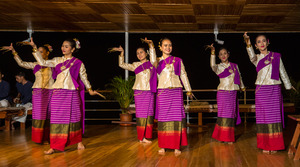 During the evening cocktail hour back on the ship Vieng related more tales, and on some nights delightful musicians and dancers come aboard to entertain us.
During the evening cocktail hour back on the ship Vieng related more tales, and on some nights delightful musicians and dancers come aboard to entertain us.
Menus featured a mix of western cuisine and Laotian specialities, the latter often eye-wateringly spicy and eagerly awaited by the lovers of hot food. By day two other passengers learned the chef could turn down the heat levels if requested. We discovered more culinary secrets when the galley team hosted a cookery lesson and demonstrated how to prepare green papaya salad.
Another day Vieng organised a language lesson, and in the afternoon we practiced our rookie ‘sabaidee’, or hello, with varying degrees of success on unsuspecting villagers.
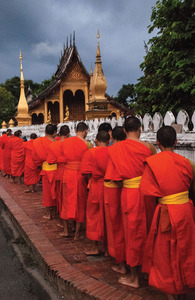 All too soon it was time to wave goodbye to Champa Pandaw and the ever-cheerful crew members. But if my wish at the lantern ceremony comes true it won’t be long before I return to this enigmatic and little-known destination and its friendly, gentle people.
All too soon it was time to wave goodbye to Champa Pandaw and the ever-cheerful crew members. But if my wish at the lantern ceremony comes true it won’t be long before I return to this enigmatic and little-known destination and its friendly, gentle people.
More information
Wendy Wu Tours offers a 12-night Laos Mekong itinerary from Chiang Saen to Vientiane, or in reverse, from £3,240pp. The fare includes one-night hotel stays at each end of the 10-night cruise, including all meals, soft drinks, domestic beers and spirits, flights with Thai Airways and transfers.
For additional information visit www.pandaw.com.
Silver Travel Advisor recommends Wendy Wu Tours.
